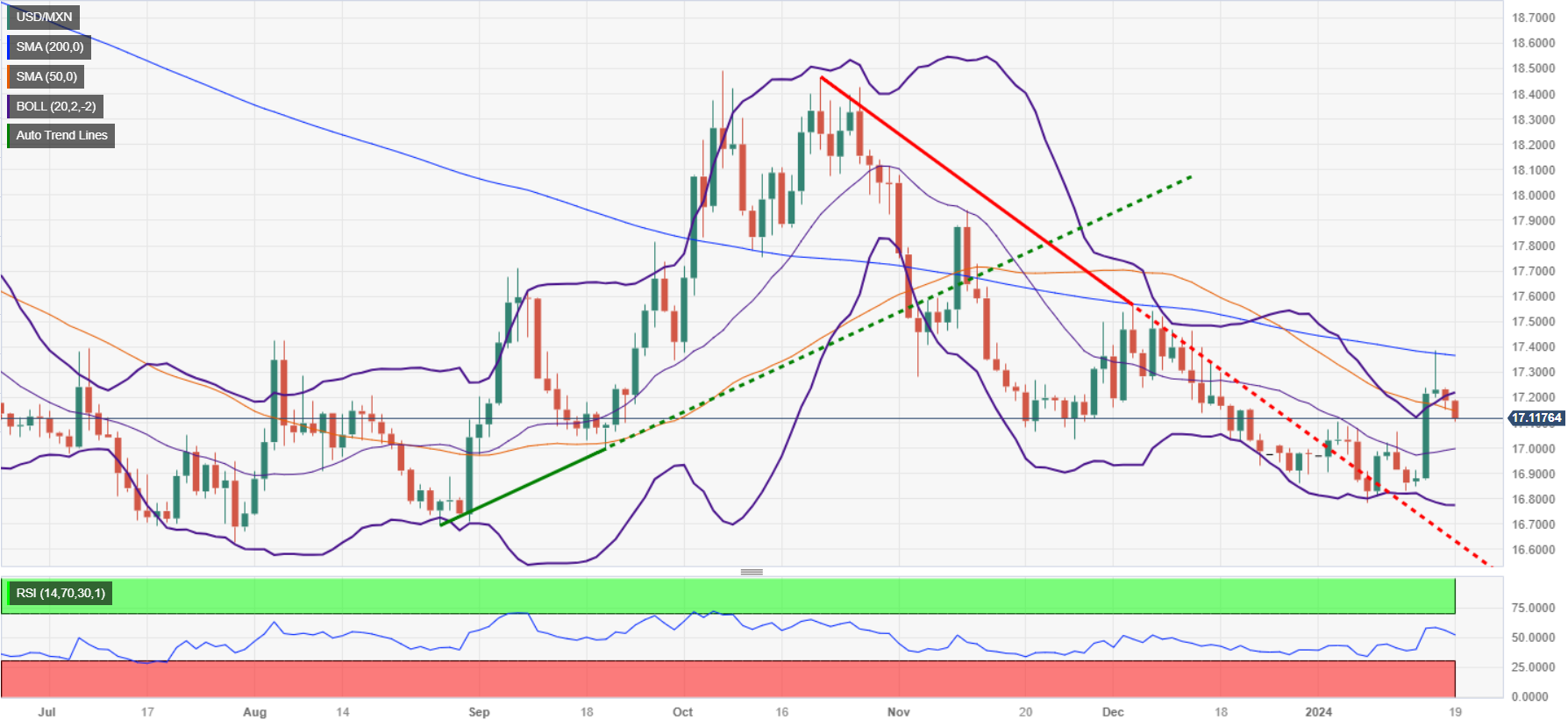- The Mexican Peso rises more than 0.15%, outpacing weak retail sales data and poor economic growth forecasts.
- Elizondo, former deputy governor of Banxico, suggests a continuation of restrictive monetary policy in Mexico.
- Improving US consumer sentiment and revised inflation expectations likely limited the Peso's advance.
He Mexican peso (MXN) posted solid gains versus US dollar (USD), but remains expected to register losses of more than 1.45% in the week, after retail sales in the country were below estimates, growing less than expected. Additionally, the National Institute of Statistics (INEGI) showed that Mexico's economy would likely grow below the 3% expected by analysts in December, in a preliminary reading of the Timely Indicator of Economic Activity (IOAE). However, the USD/MXN pair trades at 17.11, down 0.29% on the day, which favors the emerging market currency.
Meanwhile, former deputy governor of the Bank of Mexico (Banxico), Everardo Elizondo, commented that it is too early to relax monetary policy in Mexico, adding: “There are enough reasons to remain concerned.” Elizondo added, “yes [la política] relaxes, inflation expectations will deteriorate.”
Across the border, consumer sentiment improved, according to a University of Michigan survey, and households revised downward one- and five-year inflation expectations.
Daily Market Summary: Mexican Peso Regains Control Amid Mixed Data in Mexico
- Mexico retail sales rose a low 0.1% month-on-month, below forecasts of 0.5% and behind October's 0.7%. Annually, the indicator slowed from 3.4% to 2.7%, below estimates of 3.2%.
- Mexico's INEGI revealed that the Timely Indicator of Economic Activity (IOAE) anticipates economic growth of 2.6% in December.
- The preliminary reading of the Michigan Consumer Sentiment Index hit its highest level since summer 2021 and stood at 78.8, beating forecasts of 70 and the previous reading of 69.7. Joanne Hsu, Director of Consumer Surveys, said: “Consumer views were supported by confidence that inflation has turned a corner and strengthening income expectations.”
- US households' one-year inflation expectations fell from 3.1% to 2.9% and from 2.9% to 2.8% five years from now.
- Sales of existing homes fell in December as supply showed signs of improving, according to the National Association of Realtors. Sales rose by 3.78 million, below estimates of 3.82 million and below November's 0.8% increase.
- The US economy remains strong, as most data suggests that the economy continues to expand at a steady pace. Atlanta's GDPNow model suggests last year's fourth quarter would likely expand 2.4%, driven by strong retail sales, firm industrial production, a tight labor market and improving consumer sentiment.
- Following the release of the Michigan survey on consumer sentiment, investors continued to trim bets on the Federal Reserve's rate cut. At the beginning of the week, the swaps market was forecasting a rate cut of 175 basis points in 2024. But after strong US data this week, they were cut to 150 basis points.
- The biggest catalyst of the week has been Federal Reserve Governor Christopher Waller's speech: “There is no reason to move as quickly or cut as quickly as in the past.” This kept investors at bay, even though they supported rate cuts if inflation really fell.
- Mexico witnessed a spike in headline inflation, but underlying data suggests that the Bank of Mexico (Banxico) has done a good job, curbing the rise in prices after raising rates to 11.25%.
- Although the minutes of the December meeting of Banxico (the Central Bank of Mexico) indicate that the bank could consider easing its monetary policy, the December inflation report represents a possible obstacle to any relaxation of said policy.
- Analysts at Standard Chartered noted: “We expect the policy rate to be cut to 9.25% by the end of 2024, although an official downward revision of the output gap could open the door to more aggressive rate cuts.”
- On January 5, a Reuters poll suggested that the Mexican peso could weaken 5.4% to 18.00 per dollar in the 12 months to December.
Technical Analysis: The Mexican Peso remains firm, while the USD/MXN fluctuates around the 100-day SMA
USD/MXN remained trading sideways on Friday, albeit with an upward tilt as buyers reclaimed the psychological barrier of 17.00. If they push the exchange rate towards the 200-day SMA at 17.36, that could pave the way to test the 100-day SMA at 17.42. That level is ahead of the December 5 high of 17.56 and the May 23 high of 17.99.
On the other hand, the ongoing pullback below 17.20 could pave the way for a drop towards 17.00. Once overcome, a further decline is expected to the January 8 low at 16.78. Once broken, the next support would be the August 28 cycle low at 16.69, ahead of last year's low at 16.62.
USD/MXN Price Action – Daily Chart
Frequently Asked Questions about the Mexican Peso
What is MXN?
The Mexican Peso is the legal tender of Mexico. The MXN is the most traded currency in Latin America and the third most traded on the American continent. The Mexican Peso is the first currency in the world to use the $ sign, prior to the later use of the Dollar. The Mexican Peso or MXN is divided into 100 cents.
What is Banxico and how does it influence the MXN?
Banxico is the Bank of Mexico, the country's central bank. Created in 1925, it provides the national currency, the MXN, and its priority objective is to preserve its value over time. In addition, the Bank of Mexico manages the country's international reserves, acts as a lender of last resort to the banks and advises the government economically and financially. Banxico uses the tools and techniques of monetary policy to meet its objective.
How does inflation impact the MXN?
When inflation is high, the value of the Mexican Peso (MXN) tends to decrease. This implies an increase in the cost of living for Mexicans that affects their ability to invest and save. At a general level, inflation affects the Mexican economy because Mexico imports a significant amount of final consumption products, such as gas, fuel, food, clothing, etc., and a large amount of production inputs. On the other hand, the higher the inflation and debt, the less attractive the country is for investors.
How does the Dollar influence the Mexican Peso (MXN)?
The exchange rate between the USD and the MXN affects imports and exports between the United States and Mexico, and may affect demand and trade flows. The price of the Dollar against the Mexican Peso is affected by factors such as monetary policy, interest rates, the consumer price index, economic growth and some geopolitical decisions.
How does the Fed's monetary policy affect Mexico?
The exchange rate between the USD and the MXN affects imports and exports between the United States and Mexico, and may affect demand and trade flows. The price of the Dollar against the Mexican Peso is affected by factors such as monetary policy, interest rates, the consumer price index, economic growth and some geopolitical decisions.
Source: Fx Street
I am Joshua Winder, a senior-level journalist and editor at World Stock Market. I specialize in covering news related to the stock market and economic trends. With more than 8 years of experience in this field, I have become an expert in financial reporting.








